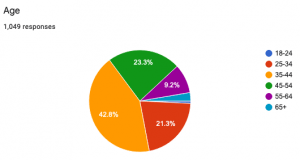New survey reveals SA mothers are tech-savvy and ready for remote working, prior to Coronavirus lockdown
Press Release by Crimson Line and RecruitMyMom on 31 March 2020
A new survey of professional working mothers across South Africa is showing that the majority want flexible and online work lives, and are ready to transition to a new remote working setup, but many are still hampered by external factors such as loadshedding and lacking provision of remote working technology by their employers.
These insights were revealed in an online survey of 1049 job seekers from across SA of which 96.5% are moms with children. It was a quantitative survey with some open-ended questions to gain deeper insights into certain topics, and was launched to gauge the technological prowess and readiness of professional job seekers in SA to work flexibly and online from home.
The survey was jointly conducted by the award-winning online recruitment agency RecruitMyMom and award-winning cloud migration consultancy Crimson Line, in January and February 2020, just before the Covid-19 pandemic struck SA. The survey population is job seekers from all over SA who were invited to participate through RecruitMyMom’s database and social media networks.
“The timing of our survey is rather significant and gives us a fascinating glimpse into our professional job seekers’ readiness to switch from traditional in-office to more remote working arrangements during this pivotal moment in history. The global Covid-19 pandemic creates a new normal for workers everywhere and our South African job-seeking professionals are ready to make themselves more productive online,” says Phillipa Geard, CEO and founder of RecruitMyMom.
Crunching the numbers on South African working moms
Of all the job seekers who participated in the survey, 67.5% are currently employed and 32.5% are out of work and needing employment. When asked what their current working arrangements were, 708 survey takers responded to the question, and 32.1% of those said they did not have any work flexibility in terms of hours or working from home. Another 33.8% said they worked full time with flexibility built into their working arrangements.
Of the 708, only 19% said they were permitted to conduct all their meetings online while working remotely. Almost 30% of the group still had to go to the office for meetings. A mere 3% of respondentsdid not have the tech knowledge or confidence to run an online meeting – the rest were all au fait with online meeting solutions such as Skype, Google Hangouts and Zoom – and almost 55% said they knew how to share their screens with colleagues and clients during online meetings.
In an open-ended question on the benefits of conducting online meetings, the responses were all positive. Cited benefits ranged from “increased productivity”, “no travel time” and “not wasting four hours in traffic every day” or “struggling with parking issues”, to “having improved workflow” and “ability to multitask”. Others said it was “more cost-effective” to work remotely, and it ensured they were “never late” for a meeting. They were also able to “work more globally”, “share a broad variety of information in real-time” with colleagues and clients, and “speak to colleagues anywhere in the world all at the same time”.
The moms said flexible working arrangements enabled them to schedule their commitments around their children, from driving them to and from school, being with their children in the afternoons, and even working flexibly when their kids were sick. Some said remote working gave them the best of both worlds because they could live in lifestyle locations, while their offices were in the urban metros. Flexible working arrangements were also a big help to single parents.
When asked what their top three considerations were in choosing a new job and working environment, the factors of salary, flexible working policy and location came out tops.
Asked what employment benefits were important to them over and above salary, a whopping 82.2% of the job seekers surveyed said they wanted flexible working hours, and 62.7% said they wanted the ability to work remotely. Medical aid came in at third place, at 47.8%. Only 1.2% said they would like to have breastfeeding facilities at work. About 65% said they wanted to work 40 hours or less per week.
When quizzed about the office technology suites they liked to use for work, 51.7% said they used Microsoft Office-based solutions, 26.8% used a combination of Microsoft and Google solutions, and 5.6% used mainly Google G-Suite. The rest used specialised software, such as the Xero accounting software, SAP enterprise resource planning software or Salesforce for cloud-based customer relationship management (CRM).
Asked how they kept their online documents safe from hackers and malware, 52% said they had security software in place and 40% had cloud-based solutions.
Asked what their greatest work-related tech challenges were, most said that loadshedding was it, although anecdotal evidence also came though that their management’s reluctance to equip them properly for remote working online was a great frustration. Encouragingly, however, 64.3% of the moms surveyed were able to carry on working during loadshedding. Asked how they were able to do this, several said they had access to a generator or Uninterrupted Power Supply (UPS) battery, although a handful also opted to create a mobile hotspot with their phone to use their own mobile data for completing office work.
In terms of online document collaboration capabilities, 41% said they were able to work collaboratively with colleagues online and use real-time online collaboration platforms, but 35% said they were not able to and had to rename documents before sending it via email to ensure that everyone in the team worked on the right version of the document. Of those that were not able to collaborate in real-time on the same document with colleagues online, almost 30% said lack of access to such tools were to blame, while 18% said they simply did not know how it worked.
However, when asked about their use of productivity apps, such as those for time-tracking, the overall current uptake was low – only a handful mentioned using apps such as Asana, Harvest, Teammate and Toggl. While many were interested in starting to use tools such as Trello, Harvest, Asana, Monday.com, Microsoft Teams, Jibble, TimeDoctor and Everhour in the future to improve their online work-lives, the majority still did not have enough knowledge of or access to such tools yet from their employers and needed more education on it.
“It is clear that there is still a great need amongst professionals in South Africa to be equipped, through technology and training, to work remotely and flexibly. South African employers should heed this call if they want to solve the problem of scarce, highly skilled resources and take on employees who can work from anywhere. As Covid-19 forces employers to reconsider how they measure remote employee productivity, the influence of remote workers on company culture and how to blend office and remote workers seamlessly, we hope that this survey will show employers that the workforce is ready to meet the demands set for them”, says Karen Koen, partner at Crimson Line.
A deep dive into the demographics of the survey respondents
The respondents surveyed in the 2020 RecruitMyMom/Crimson Line Working Moms Survey are a culturally diverse cross-section of society and 99.2% were women. The vast majority (42.8%) were in the 35-44 year age range, while 23.3% were in the 45-54 age range, and 21.3% were in the 25-35 age bracket.
Of the respondents that are unemployed, 45.7% were out of work for more than a year and 21% were out of work for between six months and a year.
At 54.1% the majority of respondents were living in Gauteng, 40.5% were from the Western Cape, and 3.2% were from KwaZulu-Natal. The Eastern Cape came in at 0.7%, North West at 0.6%, the Free State at 0.3%.
An overwhelming majority or 72.3% of the respondents have a tertiary education, with 5.7% of those having a masters degree and 0.3% having earned a doctorate.






